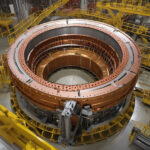Light squeezed beyond limits: New nanostructures extend the life of terahertz devices
Can you squeeze light into a space hundreds of times smaller than its natural wavelength? The answer is yes, and this revolutionary concept is paving the way for groundbreaking advancements in the field of terahertz technology. Terahertz radiation, located between microwaves and infrared light on the electromagnetic spectrum, has long held promise for applications in imaging, communication, and sensing due to its unique properties. However, harnessing terahertz radiation has been challenging due to the limitations of traditional materials and device designs.
Enter nanostructures, the tiny building blocks that are reshaping the world of terahertz technology. By manipulating light at the nanoscale level, researchers have unlocked a new realm of possibilities for terahertz devices. These nanostructures, which can be engineered to have specific optical properties, allow for the confinement and manipulation of terahertz waves in ways never thought possible.
One of the key benefits of nanostructures in terahertz devices is their ability to enhance light-matter interactions. By tailoring the size, shape, and composition of nanostructures, researchers can control how light behaves at the nanoscale, leading to improved efficiency and performance of terahertz devices. For example, nanoantennas can be used to focus terahertz radiation into tiny hotspots, increasing the intensity of the light and enabling sensitive detection of molecules or materials.
Moreover, nanostructures offer a way to extend the lifetime of terahertz devices by mitigating the effects of material degradation. Terahertz radiation can be damaging to conventional materials over time, leading to device failure and reduced performance. By incorporating nanostructures into terahertz devices, researchers can create protective layers that shield the materials from the harmful effects of terahertz radiation, ensuring long-term stability and reliability.
In addition to improving device performance and longevity, nanostructures are also enabling new functionalities in terahertz technology. Metamaterials, which are engineered composites with unique electromagnetic properties not found in nature, are being used to create terahertz devices with unprecedented capabilities. For example, metamaterial lenses can bend terahertz waves in ways that were previously impossible, leading to enhanced imaging resolution and signal processing.
The integration of nanostructures into terahertz devices is opening up a world of possibilities for applications in various industries. In the medical field, terahertz imaging technologies are being developed for non-invasive diagnostics and imaging of biological tissues. In communications, terahertz waves offer the potential for ultra-fast wireless data transfer, revolutionizing the way we connect and communicate. In security screening, terahertz sensors can detect hidden weapons or explosives with high sensitivity and specificity.
As researchers continue to push the boundaries of what is possible with nanostructures and terahertz technology, the future looks bright for this field. With ongoing advancements in materials science, device engineering, and theoretical modeling, we can expect to see even more exciting innovations in the years to come. The era of squeezing light beyond its limits is here, and the possibilities are endless.
light, terahertz, nanostructures, technology, innovations











